James Stewart watching his neighbours, who are watching each other keep an eye on one another. The film, of course, is Alfred Hitchcock’s fantastic suspense thriller Rear Window (1954).
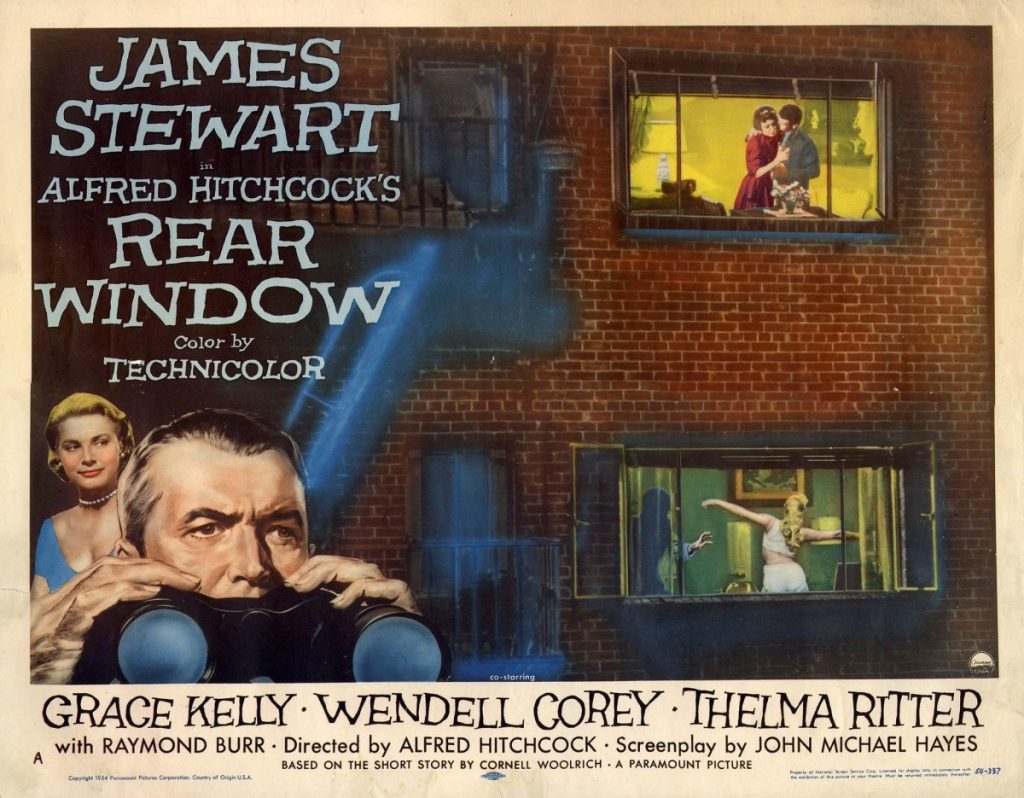
Voyeurism, curiosity, suspense and murder most horrid, are all combined to create a splendid thriller that exudes virtuosity and works on various levels of spectatorship. Hitchcock was tickled by the idea of the audience observing the protagonist, who in turn is spying on the lives of others, at first for entertainment due to boredom and a heavy dose of cabin fever, intensified by a heat wave in the city throughout the duration of the film.
Based on the short story It Had To Be Murder by Cornell Woolrich, a noted crime writer of the 1940s, Rear Window also stars the gorgeous Grace Kelly as Stewart’s girlfriend Lisa and Raymond Burr of TV’s Ironside and Perry Mason fame, playing the villain of the piece.

Shot on a huge sound stage at the Paramount Pictures lot, the action takes place in a courtyard of adjoined tenement buildings in the middle of New York city. Stewart plays an action loving, thrill seeking, photographer, L.B. Jeffries (or Jeff as he is referred to). Confined to a wheelchair with his left leg in plaster, Jeff is convalescing from an accident in which he broke his leg during a dangerous assignment. A man who craves adventure and excitement, Jeff gets bored very easily in his bijou apartment. Casually watching his neighbours from his rear window, he sits passing the hours of the day by observing their behaviour and lives from the anonymous safety of his room.
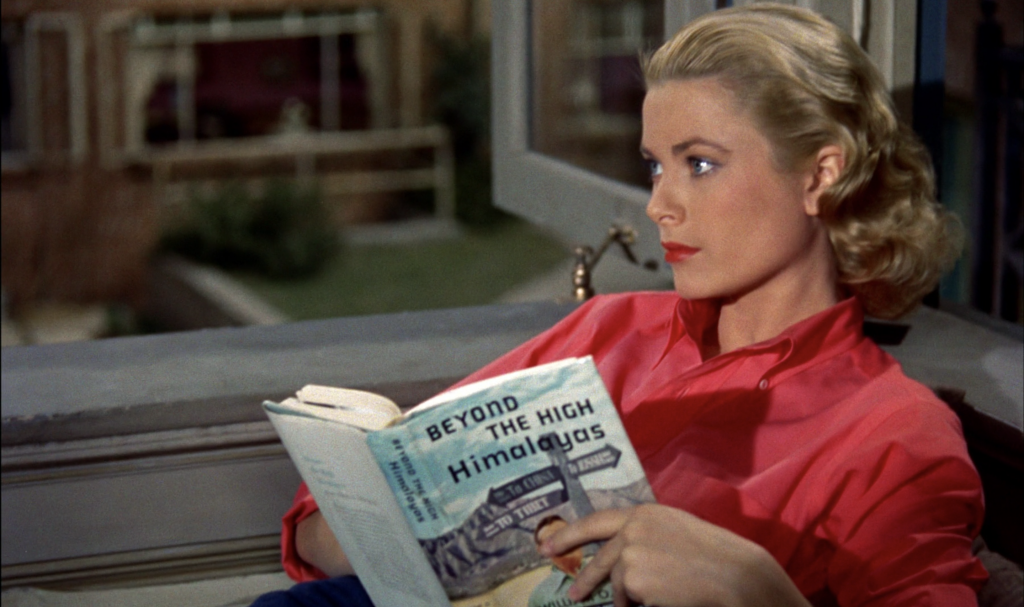
In turn, we the audience watch Jeff from behind our own screen, or window, if you will. Jeff’s curiosity begins to focus on the behaviour of one neighbour in particular, the sinister Mr. Thorwald, who Jeff believes has killed his wife and is covering it up. Although Jeff (or we the oberservers) have not seen Thorwald kill his wife, she is simply there one day and gone from her bed the next. Jeff observes Thorwald going back and to from his apartment in the wee small hours and eventually witnesses him exiting the apartment with a huge chest that is secured with strong rope.
Jeff consults his nurse Stella (played by great character actress Thelma Ritter) who is sceptical and scorns him initially for prying into people’s lives. Jeff also tells his girlfriend Lisa about his suspicions. Although she too is initially skeptical about the scenario, her interest in Jeff’s postulation gathers momentum and before long she is sitting at the window, colluding with Jeff is his stake out of the courtyard and in particular, Thorwald.
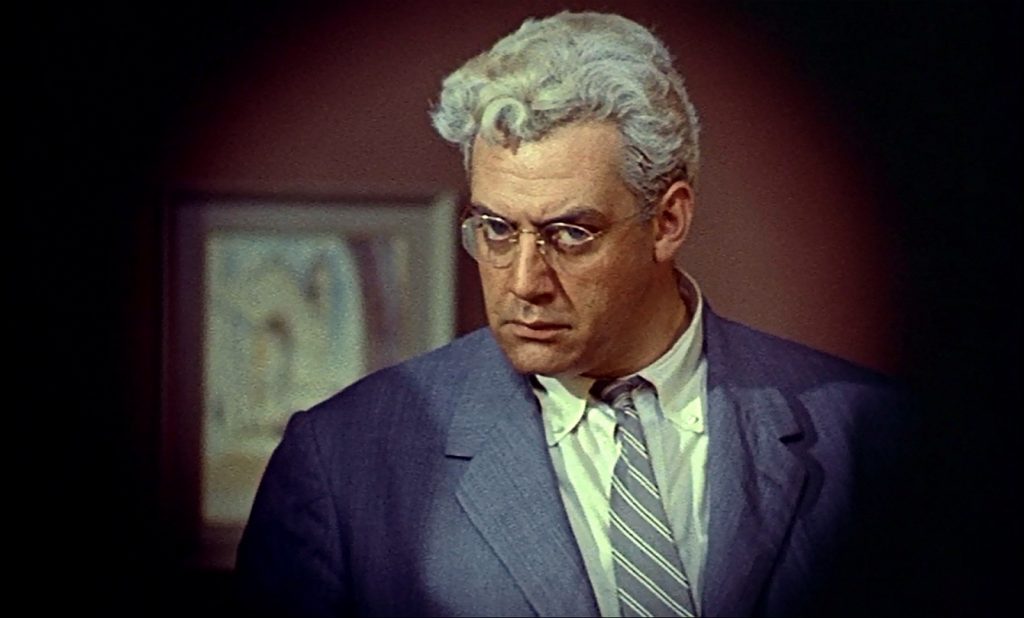
Hitchcock is a master tension builder, creating it slowly, almost clandestine in his method of bringing the intensity to boiling point. As a storyteller he is rarely equalled and Rear Window is one of his very best yarns. With some groundbreaking camera work that sweeps in and out of Jeff’s apartment and into the courtyard, using some wonderful crash-zoom style shots that give us the impression of looking through binoculars, never a second is wasted in this classic movie. Every frame is orchestrated like an intricate symphony, which brings us nicely to the subject of music in the film.
The score, as in all of Hitchcock’s films, is as intrinsic to its success as the cinematography. Composed by Franz Waxman, the dramatic motifs emphasize peril in the tense scenes and reflect serenity in the love scenes. Apart from the score, there are other musical elements in this movie. In the very first scene we hear the voice of Bing Crosby singing “To See You is To Love You” from a radio in one of the tenant’s apartments.
Here, Hitchcock creates an early allusion to two of the films major themes, voyeurism and obsession. The tenant playing the record is a lonely lady who we later see attempt to take her own life (with sleeping pills) before she is stopped by the music coming from an apartment across the courtyard, where a composer sits playing his piano. The melody that she hears is so moving and uplifting that she decides against suicide and towards the very end of the film, befriends the composer, confessing to him her story and expressing her gratitude for the positive effect that hearing the music has had on her.
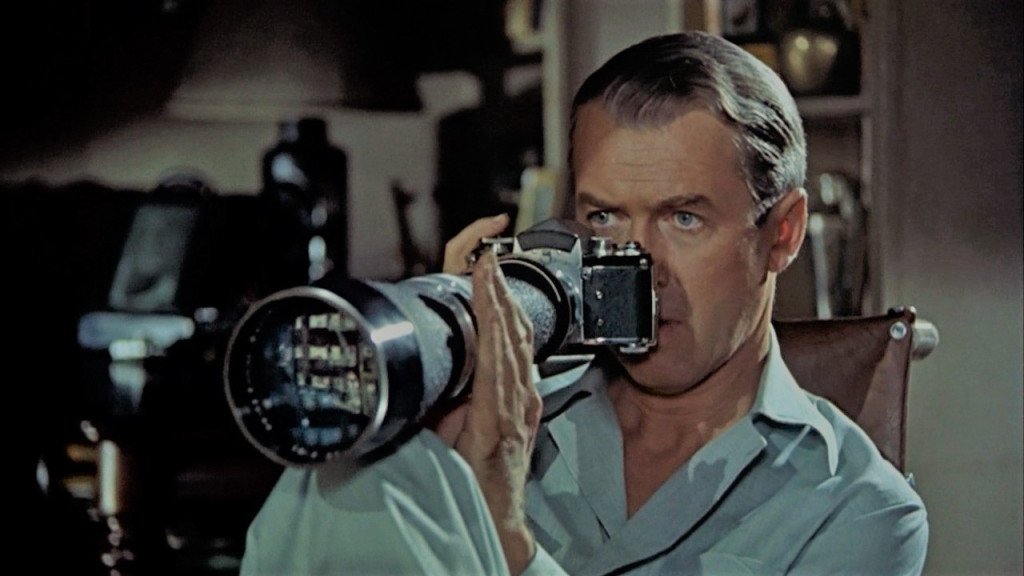
As interesting as Jeff’s obsession is with Thorwald and his murderous capabilities, it is the other neighbours that play a key supporting role in the subtext of the piece. The apartments themselves represent the screen or the cinema in a way, and James Stewart’s character represents us, the audience, obsessed with watching from a distance.
Amongst the tenants we have already mentioned, are a couple of newlyweds, another older couple (who sleep outside on the fire escape due to the heat), a young female who dances every morning and entertains gentleman at night and downstairs an artist who sculpts. Each of these character’s lives, serve as little vignettes, constantly playing in the background of the main narrative. Each vignette serves as a representation of different aspects of Jeff’s life and are perfectly placed icons to serve Hitchcock’s own ideas and themes.
The vivacuious young dancer can be seen as a representation of desire and the newly married couple represent the idea of the restrictions of married life, something which Jeff goes to great lengths to avoid with his own girlfriend, due to his own feelings of inadequacy and fear of commitment. This is perhaps the reason why he indulges in such escapism by watching his neighbours, just as we might do by watching a film. Hitchcock not just a filmmaker, he is an artist. Hence sculpture and musicianship are represented via the sculptor and the composer.
There are also interesting similarities between Jeff’s situation and that of Mr & Mrs Thorwald. When Mrs. Thorwald is still alive, she is bed ridden and being waited on by Mr. Thorwald. This is almost a mirror image of Jeff who is wheelchair bound and being cared for by his girlfriend and visiting nurse, Stella.
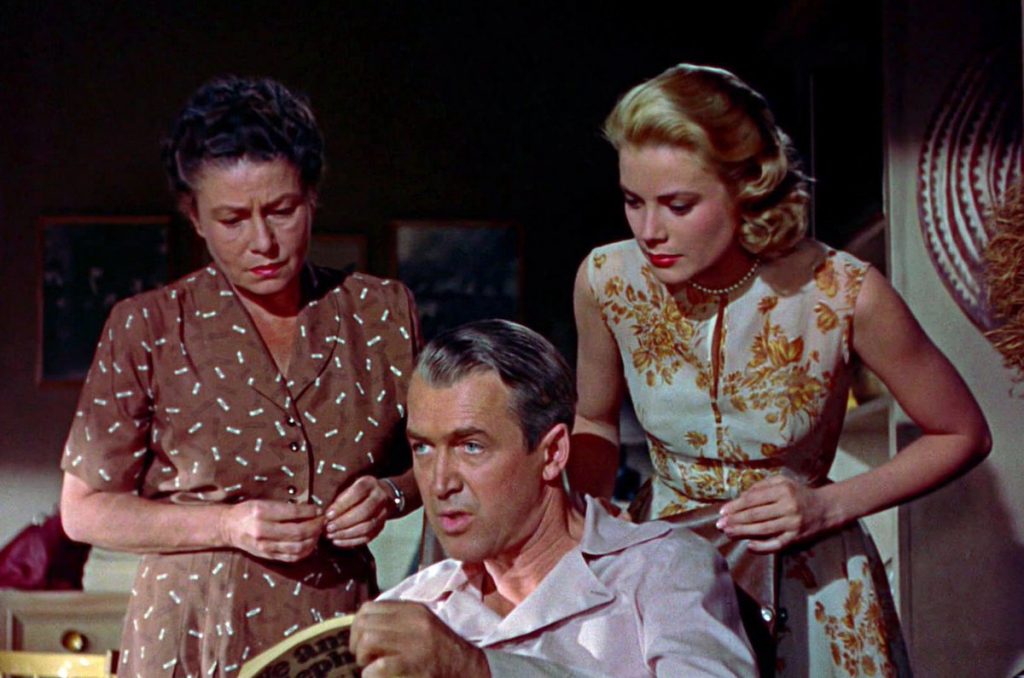
There is a lot to see in this movie and any avid film lover would want to watch it several times at least, to pick up on all the nuances contained within. In my opinion, there is no doubt that Hitchcock is a great example of an auteur. His groundbreaking camera techniques, storytelling power and genius tension building, all serve as an unnerring morass of ideas and surprises that are thematically and stylistically consistent throughout his body of work.
Although his films share these thematic elements, they are never the same formulaic story or particular subject. Alfred Hitchcock will always stand out as someone who had something unique and therefore special, when compared to the run of the mill. Like Orson Welles before him, he had more to offer than the average filmmaker and he worked ceaselessly to create his art in the highest and most groundbreaking ways possible.
The story builds to a tense finale. Having convinced themselves that Thorwald did indeed murder his wife, Jeff and Lisa (with the help of Stella) decide to lure Thorwald out of his apartment with an anonymous phone call, so that Lisa can get into his rooms via the open window and find some evidence of the murder. She does this successfully in finding the missing wife’s wedding ring but not before Thorwald comes home to catch her in the apartment. Jeff is left feeling powerless across the courtyard in his wheelchair.
Luckily a call to the police yields a speedy enough response and they arrive at Thorwald’s apartment in the nick of time. The sheer panic and frustration that James Stewart portrays in this scene is a great example of emotion being intensified by a close up shot of the protagonist’s face. Stella squeezes his shoulder in anguish and Jeff covers his mouth with his hand, preventing him from crying out and alerting Thorwald to his position.
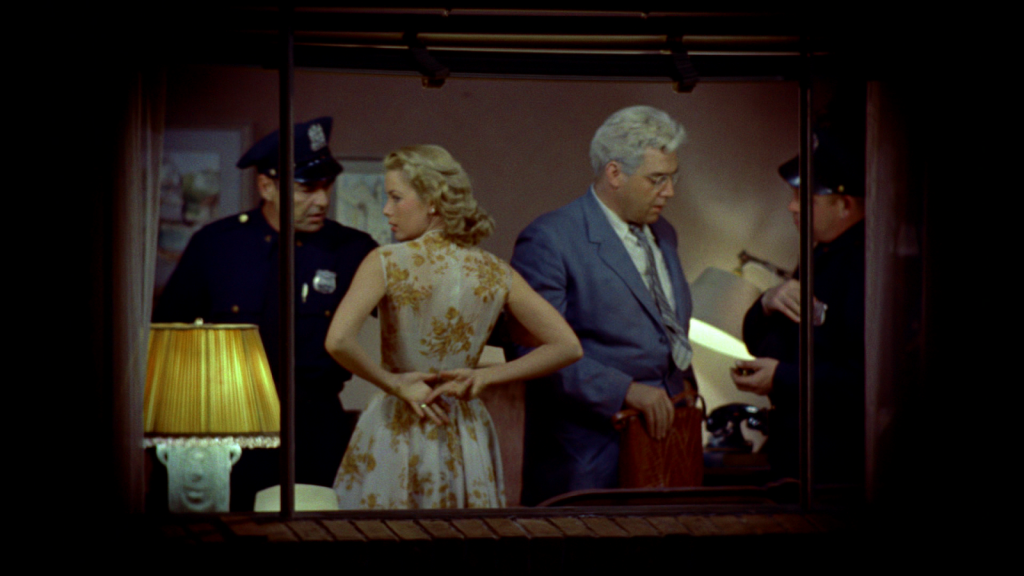
Lisa then indicates to Jeff that she has the wedding ring as evidence. As she is the intruder, she is taken away by the police and Stella leaves Jeff alone to go to the station to bail Lisa out. Jeff meanwhile keeps his eye on Thorwald through a zoom lens camera but is suddenly spotted by him. In a great shot, Thorwald looks directly at Jeff and squints slightly as if he has noticed someone watching him. The shot is rounded in an elliptical black fade, giving the effect of looking at the subject through a lens. Having realised someone is watching him, Thorwald leaves his apartment immediately and heads straight towards Jeff’s place.
In an incredible panic, Jeff is left alone in his room, handicapped and vulnerable. He clutches a stack of flash bulbs and turns out the lights. He sits awaiting the impending assailant in a state of panic. As he watches the door we see the light underneath (seeping in from the hallway) extinguish. Thorwald has cunning and foresight enough to cloak his arrival. This insinuation alone is unsettling enough and adds subtly to the sense of danger and tension. The final scene is thrilling. If you haven’t seen the film, you should and I’m not going to spoil it for you. If you have seen it, then you know what transpires.
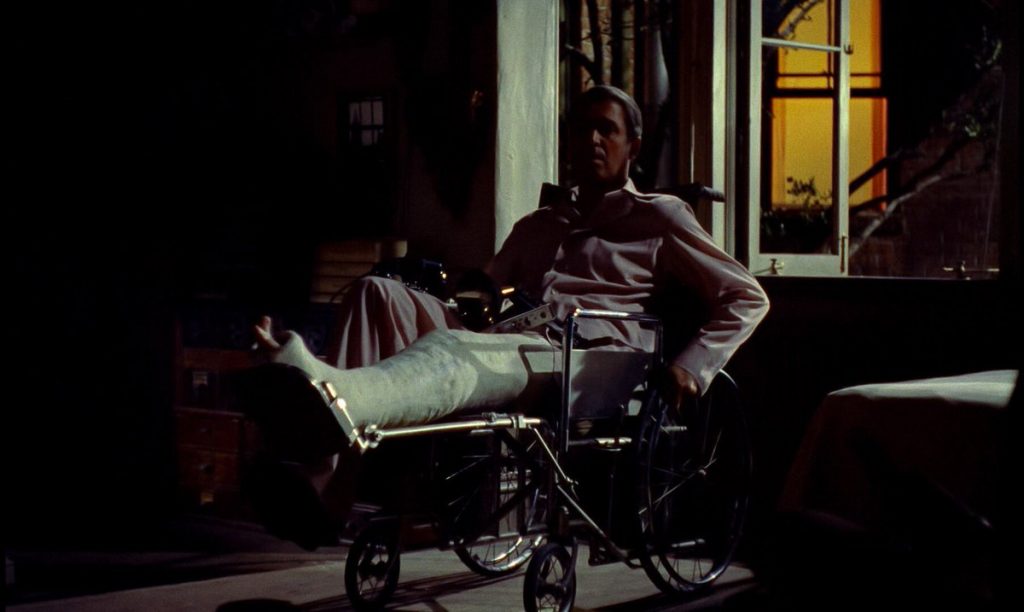
Hitchcock’s Rear Window is certainly one of his most loved films and has been much acclaimed in the 56 years since its release. Standing up to the harsh winds of time and change, it still rates as a first class example in its genre and is a must-see for any budding film aficionado. It is my opinion that Alfred Hitchcock is one of the greatest influences on contemporary film making since D.W. Griffith. As the master of suspense said himself, “The length of a film should be directly related to the endurance of the human bladder.” Such is the genius and humour of this most bizarre and original of movie directors.
Did you enjoy this article about Rear Window?
You can read more of our articles here.
Please join us on social media on Facebook, Instagram, Tik Tok and Twitter. We really appreciate all the likes, shares, retweets etc., and we would love to hear from you and continue the wonderful celebration of all things cinema on these platforms.
If you love to watch videos on YouTube, then please subscribe to our channel here. There’s lots of fun and informative videos uploaded that we hope you will enjoy!
We have a passion for movies and aim to produce entertaining and informative movie-related content. It certainly is a lot of hard work, but we love films so much that it’s worth all the effort. We have to keep the lights on and make sure we have plenty of caffeine to keep all of the articles, videos and social media posts coming, so if you like our work, then please consider supporting us at Buy Me A Coffee here. You can also become a More Movies patron on Patreon here.
To help support us here at More Movies, we do use advertising in a few places, so we appreciate it if you do not use AdBlockers on our site, as this helps keep a few pennies trickling in. We also utilise affiliate links throughout the site, usually to help guide our readers to places to stream, rent or buy the movies we talk about. One of the biggest sources for movies online is Amazon Prime Video, where you can stream over 18,000 films. If you are interested in Prime and haven’t signed up yet, you can get a 30-day free trial via this affiliate link, which helps support us too.

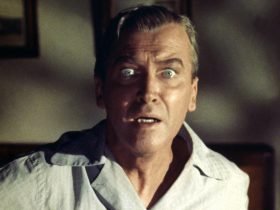
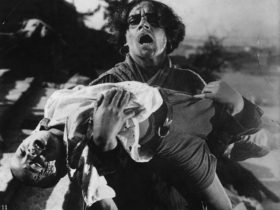



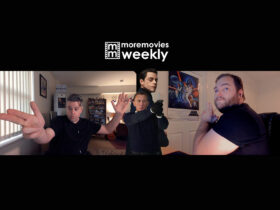





you auteur work for The Sun…